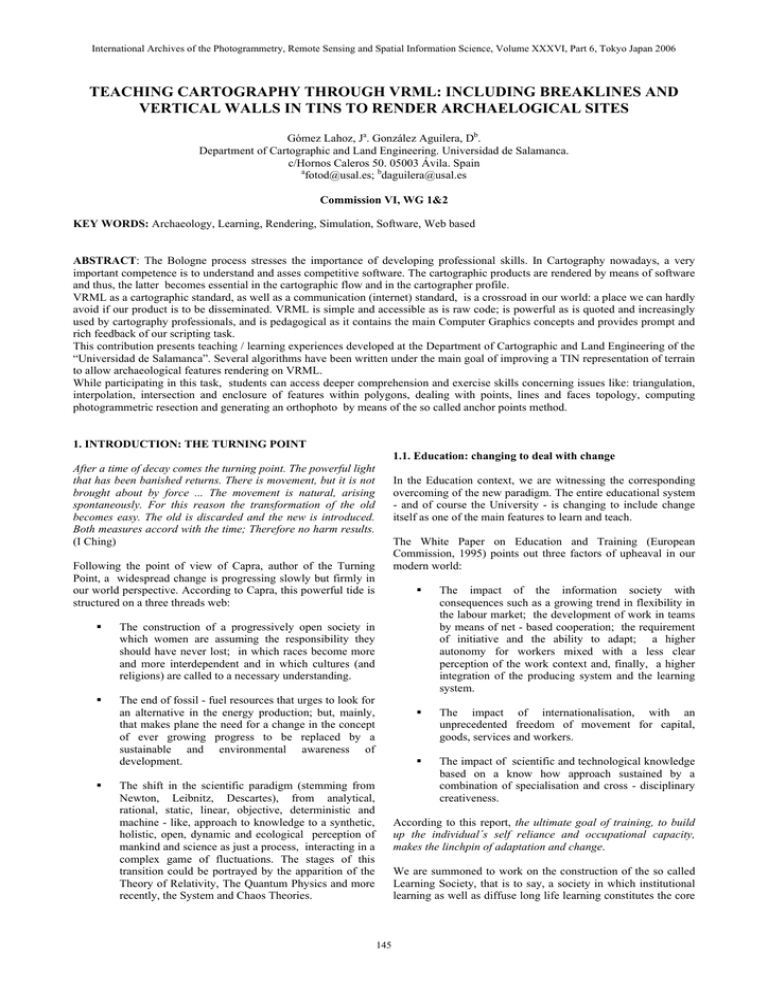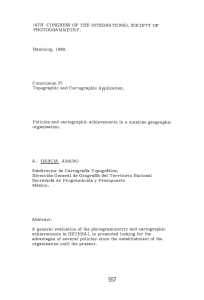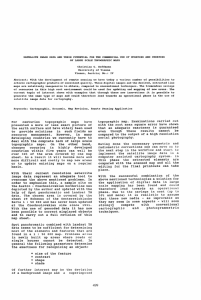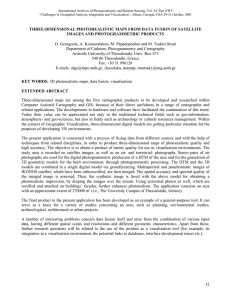TEACHING CARTOGRAPHY THROUGH VRML: INCLUDING BREAKLINES AND
advertisement

International Archives of the Photogrammetry, Remote Sensing and Spatial Information Science, Volume XXXVI, Part 6, Tokyo Japan 2006 TEACHING CARTOGRAPHY THROUGH VRML: INCLUDING BREAKLINES AND VERTICAL WALLS IN TINS TO RENDER ARCHAELOGICAL SITES Gómez Lahoz, Ja. González Aguilera, Db. Department of Cartographic and Land Engineering. Universidad de Salamanca. c/Hornos Caleros 50. 05003 Ávila. Spain a fotod@usal.es; bdaguilera@usal.es Commission VI, WG 1&2 KEY WORDS: Archaeology, Learning, Rendering, Simulation, Software, Web based ABSTRACT: The Bologne process stresses the importance of developing professional skills. In Cartography nowadays, a very important competence is to understand and asses competitive software. The cartographic products are rendered by means of software and thus, the latter becomes essential in the cartographic flow and in the cartographer profile. VRML as a cartographic standard, as well as a communication (internet) standard, is a crossroad in our world: a place we can hardly avoid if our product is to be disseminated. VRML is simple and accessible as is raw code; is powerful as is quoted and increasingly used by cartography professionals, and is pedagogical as it contains the main Computer Graphics concepts and provides prompt and rich feedback of our scripting task. This contribution presents teaching / learning experiences developed at the Department of Cartographic and Land Engineering of the “Universidad de Salamanca”. Several algorithms have been written under the main goal of improving a TIN representation of terrain to allow archaeological features rendering on VRML. While participating in this task, students can access deeper comprehension and exercise skills concerning issues like: triangulation, interpolation, intersection and enclosure of features within polygons, dealing with points, lines and faces topology, computing photogrammetric resection and generating an orthophoto by means of the so called anchor points method. 1. INTRODUCTION: THE TURNING POINT 1.1. Education: changing to deal with change After a time of decay comes the turning point. The powerful light that has been banished returns. There is movement, but it is not brought about by force ... The movement is natural, arising spontaneously. For this reason the transformation of the old becomes easy. The old is discarded and the new is introduced. Both measures accord with the time; Therefore no harm results. (I Ching) In the Education context, we are witnessing the corresponding overcoming of the new paradigm. The entire educational system - and of course the University - is changing to include change itself as one of the main features to learn and teach. The White Paper on Education and Training (European Commission, 1995) points out three factors of upheaval in our modern world: Following the point of view of Capra, author of the Turning Point, a widespread change is progressing slowly but firmly in our world perspective. According to Capra, this powerful tide is structured on a three threads web: The construction of a progressively open society in which women are assuming the responsibility they should have never lost; in which races become more and more interdependent and in which cultures (and religions) are called to a necessary understanding. The end of fossil - fuel resources that urges to look for an alternative in the energy production; but, mainly, that makes plane the need for a change in the concept of ever growing progress to be replaced by a sustainable and environmental awareness of development. The shift in the scientific paradigm (stemming from Newton, Leibnitz, Descartes), from analytical, rational, static, linear, objective, deterministic and machine - like, approach to knowledge to a synthetic, holistic, open, dynamic and ecological perception of mankind and science as just a process, interacting in a complex game of fluctuations. The stages of this transition could be portrayed by the apparition of the Theory of Relativity, The Quantum Physics and more recently, the System and Chaos Theories. The impact of the information society with consequences such as a growing trend in flexibility in the labour market; the development of work in teams by means of net - based cooperation; the requirement of initiative and the ability to adapt; a higher autonomy for workers mixed with a less clear perception of the work context and, finally, a higher integration of the producing system and the learning system. The impact of internationalisation, with an unprecedented freedom of movement for capital, goods, services and workers. The impact of scientific and technological knowledge based on a know how approach sustained by a combination of specialisation and cross - disciplinary creativeness. According to this report, the ultimate goal of training, to build up the individual´s self reliance and occupational capacity, makes the linchpin of adaptation and change. We are summoned to work on the construction of the so called Learning Society, that is to say, a society in which institutional learning as well as diffuse long life learning constitutes the core 145 International Archives of the Photogrammetry, Remote Sensing and Spatial Information Science, Volume XXXVI, Part 6, Tokyo Japan 2006 of every professional profile. A learning based both on firm and deep scientific disciplinary roots and on cross and soft views. As Sursock (2002) states "considering the long history of higher education, disciplinarity has been an organising feature of universities for only a relatively short time (mostly in the 19 th and 20 th centuries). We also know that intellectual creativity requires a certain degree of interdisciplinarity and that this trend is increasing. assurance at institutional, national and European level. They stress the need to develop mutually shared criteria and methodologies on quality assurance And going one step further: Ministers encourage the member states to elaborate a framework of comparable and compatible qualifications for their higher educations systems, which should seek to describe qualifications in terms of workload, level, learning outcomes, competences and profiles. We need to foster individual autonomy to improve own knowledge and competences along professional life. We need to stress not only practical everyday skills but also a deep comprehension of our environment, a wide capacity of emitting sound assessments a creative and dynamic view of our professional background and a keen ability for decision taking. We must take into account that (European Commission, 1995): But Quality Assurance, as stated above, is not only a standard to achieve the goal of constructing the common european space. The key feature to understand this proposal rend is the growing need for a self-reliant graduate whose skills are the same of the self-reliant learner. The main skill is to develop personal autonomy in acquiring skills and so, the education goal becomes to create incurable learners, to build learner autonomy through skills. Against this background it is not surprising that general (and not subject dependent) skills are the most valuable to get a job. According to the FIG, (1999): Individuals will be called upon to understand complex situations which will change in unforeseeable ways (...). They will have to contend with a mass of fragmentary and incomplete information open to varying interpretation Best practice promotes observation and assessment of teaching staff in the classroom together with targeted feedback from students on their perceptions of its effectiveness. Observation, common sense, curiosity, interest in the physical and social world around us and the desire to experiment (...) are the qualities which will enable us to train inventors rather than mere technology managers. In this frame, there is a key concept that gathers the meaning of them all and provides motivation and inspiration to help redesigning syllabus adequately: feedback. Professional and learning competence may be synthesized on the capability of generating, monitoring and learning from feedback: Powers of judgement and the ability to choose are two essential skills for understanding the world around us 1.2. Quality assurance and student learning approach The Bologne process, to which we must adjust our programming tasks, is the natural consequence of the framework portrayed above. As is well known, this process is based on certain features: a common structure of degrees and periods of study a common frame for syllabi a credit transferable system Developing awareness, positive attitude and gaining experience on open, related, transversal, multidisciplinar, complex and fuzzy actions / decisions where linkages are as important as deepness or specialized, vertical foundations. Developing awareness, attitude and capacity on monitoring own performance within a system of related elements. To improve is not to perfectly control every expected action and its consequences but rather to be able to deal with uncertainty and unexpected circumstances and accepting positively that own performance is improvable while confronted to real system evolution. So, we must pursue to be open minded and humble (intelligent) enough to foster (not only accept) means and channels to obtain feedback. Developing awareness, attitude and capability on modifying own performance according to results. This places the stress on evaluation and, of course, on the educational program evaluation. On one hand, it is important to suggest and encourage students to improve their self - assessment ability as a main professional skill. And on the other hand, programmers must address, while redesigning syllabi, to create an environment in which students have chances to provide themselves feedback. In this approach, the classical issue - teachers evaluating students performance - is not a final step but rather a means of achieving the former. In this common higher education space, according to the Tuning Project (2002), the main goals are: to achieve employability to build students capacity to learn in an autonomous way to acquire capacity for analysis and synthesis to acquire capacity for applying knowledge in practice This leads to a shift from a teacher centered approach with students mastering academic contents to a student centered approach with students exercising professional competences. The way in which this targets should be delivered is the Quality Assurance Concept. First of all, because it provides de main frame against which different efforts can be made comparable, and so, interchangeable. And secondly, and mainly, because it provides the tuning, the motivation and the means to build a demanding and permanently renewable system. Fortunately, this concepts are being grasped at the highest level of responsibility. According to the European Commission (2003): The quality of higher education has proven to be at the heart of the setting up of a European Higher Education Area. Ministers commit themselves to supporting further development of quality Last, but not least, we must consider the real implementation of these ideas. Unfortunately, teachers are not very fond of making 146 International Archives of the Photogrammetry, Remote Sensing and Spatial Information Science, Volume XXXVI, Part 6, Tokyo Japan 2006 changes and all this goal will come to a wreck if the microsystem, the classroom, is not a real witness of the new air. A way to deal with this is to involucrate students in the play. Not only because they are the true main characters but also because they are supposed to push more than the teacher staff itself, they are better stakeholders in the reform. As the European Commission (2003) states: technically efficient as well as able to work in teams, to communicate both orally and verbally, and to solve problems. More and more, Geomatics applications focus upon obtaining analytical automated solutions to spatial problems and upon the use of advanced visualization means to help the understanding of the results. Consequently, Geomatics syllabus must rely heavily on students ability to identify problems with spatial components, to develop potential solutions to these problems and to effectively apply existing concepts and tools to their solution. Students representatives express the highest hopes concerning the principles of the Bologna reforms and the harshest criticism concerning their implementation and frequently reductive interpretations. In Cartography nowadays, a very important competence is to understand and asses competitive software. The cartographic products are rendered by means of software and thus, the latter becomes essential in the cartographic flow and in the cartographer profile. 2. THE RISING OF GEOMATICS From the Cartography Production point of view, changes may be seen as the emergence of a new paradigm: the Geomatic Engineering. The classic disciplines: surveying, geodesy, photogrammetry and cartography have evolved, through Remote Sensing, GPS, the WWW and CAD, to settle out the Geomatic Engineering. The core of this new paradigm is GIS. Through this, geographical data is integrated in a consistent framework and made available to Land Management. Nevertheless, professional software usually is a black box, opaque to the user. But we can write and use and have our students writing and using open software. If our care is to teach and to promote our students widest understanding of our fundamentals, techniques and methods, we are almost obliged to provide them professionally demanding software that meets as well pedagogical conditions. This means transparent, dosified, comprehensible software, and this emphasizes the role played by simulation software. So we can depict the new Cartography profile by the following features: 3. VRML A growing care for an adequate quality control In which new parameters, such as dynamism or interaction, are increasingly relevant. These features have to be managed by multidisciplinary teams, aware enough of the project circumstances. To this purpose, a basic tool is a Geographical Information System. VRML, as a cartographic standard as well as a communication (internet) standard, is a crossroad in our world: a place we can hardly avoid if our product is to be disseminated. VRML is simple and accessible as is raw code, is powerful as is quoted and increasingly used by cartography professionals, and is pedagogical as it contains the main Computer Graphics concepts and provides prompt and rich feedback of our scripting task. In this new paradigm, land management by means of a consistent set of tools applied on georeferenced data is the central core. Through GIS, geographic information is made available to multidisciplinary teams (from archaeologists to risk preventers) in order to provide support for sustainable wealth to the whole society. Some powerful features are: Quality control is becoming not only an urgent need but also a basic tool. Quality Assessment is critical as a mean of preserving maps in high standards while Quality Management provides the framework in which cartography can fluently and efficiently provide interactive tools in a connected world. As the capacity of cartography surpasses the classic representation objectives, entering in an immersive context, new quality parameters have to be considered and implemented. Object based code addressing 3D reality objects and object properties. Objects - named nodes - may be grouped (and accordingly, may accept children) and so, may lead to the creation of large scenes or complicated devices. It also includes a prototyping system for encapsulating and reusing whatever recursive set of nodes. The objects (3D) support a geometry (shape and pose). This geometry is expressed by means of simple primitives or by sophisticated ones such as ElevationGrids (equivalent to cartographic raster Digital Elevation Models) or IndexedFaceSet (equivalent to cartographic 3D Triangular Irregular Networks). Objects also support a "skin" representation by means of a material implementation that may specify the surface response to light sources and by means of a texture or pattern representation of the surface. Objects may be endowed with sensors, and so, become "sensitive creatures". Sensors detect user movements through the scene or when he/she interacts with some input device. Sensors are the starting point of routes that build up an information web. Against this background, a broad space for creative and personal enrichment is available. Cartography through GIS is a field where professionals can exert their capacity of problem solving through the powerful means that Information Technologies offer. The solution of today geographical problems requires the application of concepts and skills derived from diverse disciplines. More and more, the Geomatic world is characterized by a holistic approach to dealing with spatial abstractions. Professionals must not be just graduates trained in the use of software but rather individuals with a wide reference frame, 147 International Archives of the Photogrammetry, Remote Sensing and Spatial Information Science, Volume XXXVI, Part 6, Tokyo Japan 2006 Objects (nodes) may communicate with each other through an event or message - passing mechanism. Each node type has got an event generating or receiving specification. Objects may move, may receive events from so called interpolators of different types. These interpolators compute intermediate values, rated by a clock, within a set of determined set of values specified by the designer. Then, we designed scripts in the environment of VRML to include additional information concerning regular constructive elements. This task was planned in such a way that it highlighted the cartographic fundamentals involved and stimulated students participation. The following were addressed: Objects may be integrated in a decision taking (intelligent) frame. Flow control may be held by so called scripts in which java or javascript code may be written to analyze diverse circumstances and, consequently, adopt the better response. A Triangular Irregular Network generation from a point cloud input. This was supported by de IndexedLineSet node and, specifically, by its coord and coordIndex fields. 4. OUR EXPERIENCE We would like to present some teaching / learning experiences developed at the Department of Cartographic and Land Engineering of the Universidad de Salamanca concerning algorithms under the main goal of improving a TIN representation of terrain to allow archaeological features rendering. Figure 3. Raw TIN of House 1 Students participating in this task may access deeper comprehension and exercise skills concerning issues like: triangulation, interpolation, intersection and enclosure of features within polygons, dealing with points, lines and faces topology, computing photogrammetric resection and generating an orthophoto by means of the so called anchor points method. Two aerial (vertical) and stereoscopic images (obtained by means of a captive blimp) are the input to generate a 3D model of House 1 at the ruins of the roman city of Clunia (Spain). As is well known aerial photogrammetry cannot plot vertical walls (both excavated or constructed on the ground). So, we used a conventional photogrammetric approach to capture, on one side, a dense point cloud rendering terrain and, on the other side, a specific straight and curved line representation of the upper side of the walls (if possible). A Triangular Irregular Network generation structured over breaklines: consecutive points on the breakline provide sides of triangles and thus provide a first set of triangles. Breakline crossing becomes forbidden. Students can, thus, build out and experience the importance of this geometric feature. Figure 4. Raw TIN vs. Breakline TIN Figure 1 and figure 2. Aerial image of House 1 at Clunia, obtained by means of our blimp “Valentín” 148 An orthophoto generation by means of the so called anchor point method and a TIN texture mapping from the image texture: after solving image resection, we computed a back projection of the terrain points on the more favourable image. Then we established the same terrain triangulation on the image and finally, projected forward each triangle texture on the image on its matching terrain triangle. We took International Archives of the Photogrammetry, Remote Sensing and Spatial Information Science, Volume XXXVI, Part 6, Tokyo Japan 2006 advantage of the IndexedFaceSet node and, specifically, its texCoord and textCoordIndex fields. Immediate didactic consequences arised from working at this task. Figure 5. Orthophoto projected on TIN of House 1 A vertical wall generation: the lines of the upper side of the walls were vertically projected on the terrain. This demanded dealing with the TIN topology, interpolating and adding texture to the new polygons. Figure 7. Excavated vertical walls on the TIN Figure 8. Mixed situation with walls constructed / excavated on TIN Figure 6. Upper side of walls projected on TIN A vertical wall generation / excavation to meet a composition of the two precedent situations. The wall is constructed on one of its sides but excavated on the other. In this case the upper parts of the wall were included in the TIN and afterwards, identified as walls. As in the precedent case, every original triangle was substituted by a vertical and horizontal one. A vertical wall excavation: as TIN is not able to render vertical walls excavated on the terrain we needed to change original triangles leaning against the upper side of the wall and on the ground (wherever the photogrammetric procedure make it possible) for an horizontal (ground) and a vertical (wall) triangle. Again, this demanded dealing with the TIN topology, interpolating and adding texture to the new polygons. 5. CONCLUSIONS Although students were not obliged to, they participated actively through all the steps listed above and their attitude was, in every sense, extraordinary. They offered help and support and, furthermore, they actively involucrated in every task they felt at ease. A very good atmosphere between teachers and students has been created and this has highly benefited the students (also teachers) performance. We can point out: 149 Students learned VRML code. Though this is an important goal, is, by far, the least important of them all. International Archives of the Photogrammetry, Remote Sensing and Spatial Information Science, Volume XXXVI, Part 6, Tokyo Japan 2006 Students exercised the systematic approach demanded by every programming task This leads to the organizing capacity. Sursock, A. 2002. "Reflection from the higher education institutions point of view: accreditation an quality culture". International conference on accreditation and quality assurance. Amsterdam. The Netherlands Students learned to coordinate and to work in teams, distributing effort and exchanging results and experience. Task force on the development of model undergraduate curricula. 2003. "The Strawman Report". University Consortium for Geographic Information Science. Students acquired a big dose of interest and motivation in the Geomatic Engineering as they worked with real material and real demands and achieved real and competitive results. Tuning. 2002. Tuning educational structures in europe" http://www.relint.deusto.es/TUNINGProject/index.htm Students grasped the Geomatic fundamentals and procedures involved in the executed task in a wider and deeper way than they would have achieved in a less inmersive way. Wagenaar, 2002. "Educational structures, Learning Outcomes, Workload and the calculation of ECTS credits" http://www.relint.deusto.es/TUNINGProject/line3.asp Woods, D.R. 1996. "Problem-based learning, especially in the context of large classes". http://chemeng.mcmaster.ca./pbl/pbl.htm 6. REFERENCES Capra, F. 1982 "The turning point" Simon & Schuster. New York Carey, R. Bell G. 1998. "The annotated VRML 2.0 reference manual" Addison - Wesley CQFW. NICATS. NUCCAT. SEEC. 2001. "Credit and HE qualifications. Credit guidelines for HE qualifications in England, Wales and northern ireland". http://www.hefce.ac.uk/pubs/hefce/2001/01_66.htm Danish Evaluation Institute. 2003. "Transnational European Evaluation Program" http://www.enqa.net/texts/TEEPHY.htm Enemark, S. Plimmer F. 2002. "Mutual recognition of professional qualifications" http://www.fig.net/pub/proceedings/korea/fullpapers/plenary1/enemark-plimmer.htm European Commision. 1995. "White Paper on Education and Training. Teaching and learning. Towards the learning society" http:// http://aei.pitt.edu/1132/ European Commission. 2003. "From Berlin to Bergen. The EU contribution" http://www.bologna-berlin2003.de/pdf/Berlin_Bergen.pdf Fallows, S. Steven C. 2000. "Integrating key skills in higher education" Clays Ltd, Great Britain Felder, R. Brent, R. 2003. "Designing and teaching courses to satisfy the ABET engineering criteria". http://www.ncsu.edu/effective_teaching.htm F.I.G. 1999 "Quality assurance in surveying education". FIG publications. http://www.fig.net/pub/figpub/pub19/figpub19.htm Morgan, P Hodkinson, R. Enemark, S. 2002. "Quality assurance in surveying education". FIG Publications. http://www.ddl.org/figtree/pub/figpub/pub19/figpub19.htm Plimmer F. Sayce S. 2003. "Ethics and professional standards for surveyors. Towards a Global Standard?" FIG Worrking Week 2003. 150





